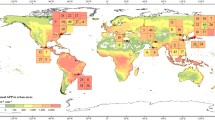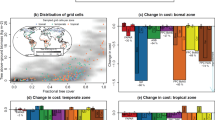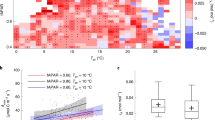Abstract
We integrated a photosynthetic sub-model into the daily Century model (DayCent) to improve the estimations of seasonal changes in carbon fluxes at the Niwot Ridge LTER site and the Harvard forest LTER site (DayCent-Photo). The photosynthetic sub-model, adapted from the SIPNET/PnET family of models, includes solar radiation and vapor pressure deficit controls on production, as well as temperature and water stress terms. A key feature we added to the base photosynthetic equations is the addition of a variable maximum net photosynthetic rate (Amax). We optimized the parameters controlling photosynthesis using a variation of the Metropolis-Hastings algorithm along with data-assimilation techniques. The model was optimized and validated against observed net ecosystem exchange (NEE) and estimated gross primary production (GPP) and ecosystem respiration (RESP) values for AmeriFlux sites at Niwot Ridge and Harvard forest. The inclusion of a variable Amax rate greatly improved model performance (NEE RMSE = 0.63 gC·m–2, AIC = 2099) versus a version with a single Amax parameter (NEE RMSE = 0.74 gC·m–2, AIC = 3724). DayCent-Photo was able to capture the inter-annual and seasonal flux patterns for NEE, GPP, ecosystem respiration (RESP), and daily actual evapotranspiration (AET), but tended to overestimate yearly NEE uptake. The DayCent-Photo model has been successfully set up to simulate daily NEE, GPP, RESP, and AET for deciduous forest, conifer forests, and grassland systems in the US using AmeriFlux data sets and has recently been improved to include the impact of UV radiation surface litter decay (DayCent-UV). The simulated influence of a variable Amax rate suggests a need for further studies on the process controls affecting the seasonal photosynthetic rates. The results for all of the forest and grassland sites show that maximum Amax values occurs early during the growing period and taper off toward the end of the growing season.
Similar content being viewed by others
References
Aber J D, Federer C A (1992). A generalized, lumped-parameter model of photosynthesis, evapotranspiration and net primary production in temperate and boreal forest ecosystems. Oecologia, 92(4): 463–474
Baldocchi D D (2008). Breathing of the terrestrial biosphere: lessons learned from a global network of carbon dioxide flux measurement systems. Aust J Bot, 56(1): 1–26
Baldocchi D D (2003). Assessing the eddy covariance technique for evaluating carbon dioxide exchange rates of ecosystems: past, present and future. Glob Change Biol, 9(4): 479–492
Baldocchi D D, Hincks B B, Meyers T P (1988). Measuring biosphereatmosphere exchanges of biologically related gases with micrometeorological methods. Ecology, 69(5): 1331–1340
Blanken P D, Monson R K, Burns S P, Turnipseed A A (2010). Data and Information for the US-NR1 Niwot Ridge Subalpine Forest AmeriFlux Site (LTER NWT1). AmeriFlux Management Project. Lawrence Berkeley National Laboratory, California
Bourdeau P F (1959). Seasonal variations of the photosynthetic efficiency of evergreen conifers. Ecology, 40(1): 63–67
Braswell B H, Sacks W J, Linder E, Schimel D S (2005). Estimating diurnal to annual ecosystem parameters by synthesis of a carbon flux model with eddy covariance net ecosystem exchange observations. Glob Change Biol, 11(2): 335–355
Chen M, Parton W J, Adair E C, Asao S, Hartman M D, Gao W (2016). Simulation of the effects of photodecay on long-term litter decay using DayCent. Ecosphere, 7(12): e01631
Chen M, Parton WJ, Del Grosso S J, Hartman M D, Day K A, Tucker C J, Derner J D, Knapp A K, Smith W K, Ojima D S, Gao W (2017). The signature of sea surface temperature anomalies on the dynamics of semiarid grassland productivity. Ecosphere, 8(12): e02069
Del Grosso S J, Parton W J, Mosier A R, Hartman M D, Brenner J, Ojima D S, Schimel D S (2001). Simulated Interaction of Carbon Dynamics and Nitrogen Trace Gas Fluxes Using the DAYCENT Model. In: Shaffer M J, Ma L W, Hansen S, eds. Modeling Carbon and Nitrogen Dynamics for Soil Management. Boca Raton: CRC Press, 303–332
Del Grosso S J, Parton W J, Mosier A R, Ojima D S, Kulmala A E, Phongpan S (2000). General model for N2O and N2 gas emissions from soils due to dentrification. Global Biogeochem Cycles, 14(4): 1045–1060
Del Grosso S J, Parton W J, Stohlgren T J, Zheng D L, Bachelet D, Prince S, Hibbard K, Olson R (2008). Global potential net primary production predicted from vegetation class, precipitation, and temperature. Ecology, 89(8): 2117–2126
Delbart N, Picard G, Le Toan T, Kergoat L, Quegan S, Woodward I, Dye D, Fedotova V (2008). Spring phenology in boreal Eurasia over a nearly century time scale. Glob Change Biol, 14(3): 603–614
Drake J E, Raetz L M, Davis S C, Delucia E H (2010). Hydraulic limitation not declining nitrogen availability causes the age-related photosynthetic decline in loblolly pine (Pinus taeda L.). Plant Cell Environ, 33(10): 1756–1766
Fisher R A (1932). Inverse probability and the use of likelihood. Math Proc Camb Philos Soc, 28(03): 257–261
Frey S D, Lee J, Melillo J M, Six J (2013). The temperature response of soil microbial efficiency and its feedback to climate. Nat Clim Chang, 3(4): 395–398
Gea-Izquierdo G, Mäkelä A, Margolis H, Bergeron Y, Black T A, Dunn A, Hadley J, Paw U K T, Falk M, Wharton S, Monson R, Hollinger D Y, Laurila T, Aurela M, McCaughey H, Bourque C, Vesala T, Berninger F (2010). Modeling acclimation of photosynthesis to temperature in evergreen conifer forests. New Phytol, 188(1): 175–186
Granda E, Scoffoni C, Rubio-Casal A E, Sack L, Valladares F (2014). Leaf and stem physiological responses to summer and winter extremes of woody species across temperate ecosystems. Oikos, 123 (11): 1281–1290
Guan M, Jin Z, Wang Q, Li Y, Zuo W (2014). Response of photosynthesis traits of dominant plant species to different light regimes in the secondary forest in the area of Qiandao Lake, Zhejiang, China. China Journal of Applied Ecology, 25: 1615–1622
Hartman M D, Baron J S, Ewing H A, Weathers K C (2014). Combined global change effects on ecosystem processes in nine U.S. topographically complex areas. Biogeochemistry, 119(1–3): 85–108
Helms J A (1965). Diurnal and seasonal patterns of net assimilation in Douglas-Fir, Pseudotsuga Menziesii (Mirb). Franco, as Influenced by Environment. Ecology, 46(5): 698–708
Hilborn R, Mangel M (1997). The ecological detective: confronting models with data. Monogr Popul Biol, 28: 315
Hurtt G C, Armstrong R (1996). A pelagic ecosystem model calibrated with BATS data. Deep Sea Res Part II Top Stud Oceanogr, 43(2–3): 653–683
Huxman T E, Turnipseed A A, Sparks J P, Harley P C, Monson R K (2003). Temperature as a control over ecosystem CO2 fluxes in a high-elevation, subalpine forest. Oecologia, 134(4): 537–546
Johnson J B, Omland K S (2004). Model selection in ecology and evolution. Trends Ecol Evol, 19(2): 101–108
Kelly R H, Parton W J, Hartman M D, Stretch L K, Ojima D S, Schimel D S (2000). Intra-annual and interannual variability of ecosystem processes in shortgrass steppe. Journal of Geophysical Research: Atmospheres, 105(D15): 20093–20100
Li Z, Li X, Rubert-Nason K F, Yang Q, Fu Q, Feng J, Shi S (2018). Photosynthetic acclimation of an evergreen broadleaved shrub (Ammopiptanthus mongolicus) to seasonal climate extremes on the Alxa Plateau, a cold desert ecosystem. Trees (Berl), 32(2): 603–614
Linkosalo T, Häkkinen R, Terhivuo J, Tuomenvirta H, Hari P (2009). The time series of flowering and leaf bud burst of boreal trees (1846-2005) support the direct temperature observations of climatic warming. Agric Meteorol, 149(3–4): 453–461
Luyssaert S, Ciais P, Piao S L, Schulze E D, Jung M, Zaehle S, Schelhaas M J, Reichstein M, Churkina G, Papale D, Abril G, Beer C, Grace J, Loustau D, Matteucci G, Magnani F, Nabuurs G J, Verbeeck H, Sulkava M, van der WERF G R, Janssens I A (2010). The European carbon balance. Part 3: forests. Glob Change Biol, 16 (5): 1429–1450
Luyssaert S, Schulze E D, Börner A, Knohl A, Hessenmöller D, Law B E, Ciais P, Grace J (2008). Old-growth forests as global carbon sinks. Nature, 455(7210): 213–215
Marshall J D, Rehfeldt G E, Monserud R A (2001). Family differences in height growth and photosynthetic traits in three conifers. Tree Physiol, 21(11): 727–734
Martinez K A, Fridley J D (2018). Acclimation of leaf traits in seasonal light environments: Are non-native species more plastic? J Ecol, 20: 207–216
Massman W J, Lee X (2002). Eddy covariance flux corrections and uncertainties in long-term studies of carbon and energy exchanges. Agric Meteorol, 113(1–4): 121–144
McGarvey R C, Martin T A, White T L (2004). Integrating within-crown variation in net photosynthesis in loblolly and slash pine families. Tree Physiol, 24(11): 1209–1220
Mohren G M J, van de Veen J R (1995). Forest growth in relation to site conditions. Application of the model forgro to the Solling spruce site. Ecol Modell, 83(1–2): 173–183
Monson R K, Sparks J P, Rosenstiel T N, Scott-Denton L E, Huxman T E, Harley P C, Turnipseed A A, Burns S P, Backlund B, Hu J (2005). Climatic influences on net ecosystem CO2 exchange during the transition from wintertime carbon source to springtime carbon sink in a high-elevation, subalpine forest. Oecologia, 146(1): 130–147
Monson R K, Turnipseed A A, Sparks J P, Harley P C, Scott-Denton L E, Sparks K, Huxman T E (2002). Carbon sequestration in a highelevation, subalpine forest. Glob Change Biol, 8(5): 459–478
Moore D J P, Hu J, Sacks W J, Schimel D S, Monson R K (2008). Estimating transpiration and the sensitivity of carbon uptake to water availability in a subalpine forest using a simple ecosystem process model informed by measured net CO2 and H2O fluxes. Agric Meteorol, 148(10): 1467–1477
Papale D, Valentini R (2003). A new assessment of European forests carbon exchanges by eddy fluxes and artificial neural network spatialization. Glob Change Biol, 9(4): 525–535
Parton W J, Hanson P J, Swanston C, Torn M, Trumbore S E, Riley W, Kelly R (2010). ForCent model development and testing using the enriched background isotope study experiment. J Geophys Res, 115 (G4): G04001
Parton WJ, Hartman M, Ojima D, Schimel D (1998). DAYCENT and its land surface submodel: description and testing. Global Planet Change, 19(1–4): 35–48
Parton W J, Rasmussen P E (1994). Long-term effects of crop management in wheat/fallow: II. CENTURY model simulations. Soil Sci Soc Am J, 58(2): 530–536
Parton W, Holland E A, Del Grosso S J, Hartman D, Martin M, Mosier A, Ojima D S, Schimel D S (2001). Generalized model for NOx and N2O emissions from soils. J Geophys Res, 106(D15): 17403–17419
Paustian K, Parton W J, Persson J (1992). Modeling soil organic matter in organic-amended and nitrogen-fertilized long-term plots. Soil Sci Soc Am J, 56(2): 476–488
Piao S, Ciais P, Friedlingstein P, Peylin P, Reichstein M, Luyssaert S, Margolis H, Fang J, Barr A, Chen A, Grelle A, Hollinger D Y, Laurila T, Lindroth A, Richardson A D, Vesala T (2008). Net carbon dioxide losses of northern ecosystems in response to autumn warming. Nature, 451(7174): 49–52
Rastetter E B, Aber J D, Peters D P C, Ojima D S, Burke I C (2003). Using mechanistic models to scale ecological processes across space and time. Bioscience, 53(1): 68
Reichstein M, Falge E, Baldocchi D, Papale D, Aubinet M, Berbigier P, Bernhofer C, Buchmann N, Gilmanov T, Granier A, Grunwald T, Havrankova K, Ilvesniemi H, Janous D, Knohl A, Laurila T, Lohila A, Loustau D, Matteucci G, Meyers T, Miglietta F, Ourcival J M, Pumpanen J, Rambal S, Rotenberg E, Sanz M, Tenhunen J, Seufert G, Vaccari F, Vesala T, Yakir D, Valentini R (2005). On the separation of net ecosystem exchange into assimilation and ecosystem respiration: review and improved algorithm. Glob Change Biol, 11(9): 1424–1439
Richardson A D, Keenan T F, Migliavacca M, Ryu Y, Sonnentag O, Toomey M (2013). Climate change, phenology, and phenological control of vegetation feedbacks to the climate system. Agric Meteorol, 169: 156–173
Ryan M G, Waring R H (1992). Maintenance respiration and stand development in a young subalpine lodgepole pine forest. Ecology, 73: 2100–2108
Sacks WJ, Schimel D S, Monson R K (2007). Coupling between carbon cycling and climate in a high-elevation, subalpine forest: a modeldata fusion analysis. Oecologia, 151(1): 54–68
Sacks WJ, Schimel D S, Monson R K, Braswell B H (2006). Model-data synthesis of diurnal and seasonal CO2 fluxes at Niwot Ridge, Colorado. Glob Change Biol, 12(2): 240–259
Savage K E, Parton WJ, Davidson E A, Trumbore S E, Frey S D (2013). Long-term changes in forest carbon under temperature and nitrogen amendments in a temperate northern hardwood forest. Glob Change Biol, 19(8): 2389–2400
Schimel D (1995). Terrestrial ecosystems and the carbon cycle. Glob Change Biol, 1(1): 77–91
Speckman H N, Frank J M, Bradford J B, Miles B L, Massman W J, Parton W J, Ryan M G (2015). Forest ecosystem respiration estimated from eddy covariance and chamber measurements under high turbulence and substantial tree mortality from bark beetles. Glob Change Biol, 21(2): 708–721
Tang X, Wang X, Wang Z, Liu D, Jia M, Dong Z, Xie J, Ding Z, Wang H, Liu X (2013). Influence of vegetation phenology on modelling carbon fluxes in temperate deciduous forest by exclusive use of MODIS time-series data. Int J Remote Sens, 34(23): 8373–8392
Tang X, Wang Z, Liu D, Song K, Jia M, Dong Z, Munger J W, Hollinger D Y, Bolstad P V, Goldstein A H, Desai A R, Dragoni D, Liu X (2012). Estimating the net ecosystem exchange for the major forests in the northern United States by integrating MODIS and AmeriFlux data. Agric Meteorol, 156: 75–84
Turnipseed A A, Anderson D E, Blanken P D, Baugh WM, Monson R K (2003). Airflows and turbulent flux measurements in mountainous terrain. Part 1. Canopy and local effects. Agric Meteorol, 119(1–2): 1–21
Turnipseed A A, Anderson D E, Burns S, Blanken P D, Monson R K (2004). Airflows and turbulent flux measurements in mountainous terrain: Part 2: Mesoscale effects. Agric Meteorol, 125(3–4): 187–205
Turnipseed A A, Blanken P D, Anderson D E, Monson R K (2002). Energy budget above a high-elevation subalpine forest in complex topography. Agric Meteorol, 110(3): 177–201
Urban O, Holub P, Klem K (2017). Seasonal courses of photosynthetic parameters in sun- and shade-acclimated spruce shoots. Beskydy, 10 (1–2): 49–56
Wang Y P, Baldocchi D, Leuning R, Falge E, Vesala T (2007). Estimating parameters in a land-surface model by applying nonlinear inversion to eddy covariance flux measurements from eight FLUXNET sites. Glob Change Biol, 13(3): 652–670
Wang Y P, Barrett D J (2003). Estimating regional terrestrial carbon fluxes for the Australian continent using a multiple-constraint approach I. Using remotely sensed data and ecological observations of net primary production. Tellus B Chem Phys Meterol, 55: 270–289
Weiskittel A R, Maguire D, Garber S M, Kanaskie A (2006). Influence of Swiss needle cast on foliage age-class structure and vertical foliage distribution in Douglas-fir plantations in north coastal Oregon. Can J Res, 36(6): 1497–1508
Zhang Y J, Holbrook N M, Cao K F (2014). Seasonal dynamics in photosynthesis of woody plants at the northern limit of Asian tropics: potential role of fog in maintaining tropical rainforests and agriculture in Southwest China. Tree Physiol, 34(10): 1069–1078
Zhang Y J, Sack L, Cao K F, Wei X M, Li N (2017). Speed versus endurance tradeoff in plants: leaves with higher photosynthetic rates show stronger seasonal declines. Sci Rep, 7(1): 42085
Ziello C, Estrella N, Kostova M, Koch E, Menzel A (2009). Influence of altitude on phenology of selected plant species in the Alpine region (1971-2000). Clim Res, 39: 227–234
Zobitz J M, Moore D J P, Sacks W J, Monson R K, Bowling D R, Schimel D S (2008). Integration of process-based soil respiration models with whole-ecosystem CO2 measurements. Ecosystems (N Y), 11(2): 250–269
Acknowledgements
This work is supported by the US Department of Agriculture (USDA) UV-B Monitoring and Research Program, Colorado State University, under USDA National Institute of Food and Agriculture Grant 2016-34263-25763.
Author information
Authors and Affiliations
Corresponding authors
Rights and permissions
About this article
Cite this article
Straube, J.R., Chen, M., Parton, W.J. et al. Development of the DayCent-Photo model and integration of variable photosynthetic capacity. Front. Earth Sci. 12, 765–778 (2018). https://doi.org/10.1007/s11707-018-0736-6
Received:
Accepted:
Published:
Issue Date:
DOI: https://doi.org/10.1007/s11707-018-0736-6




